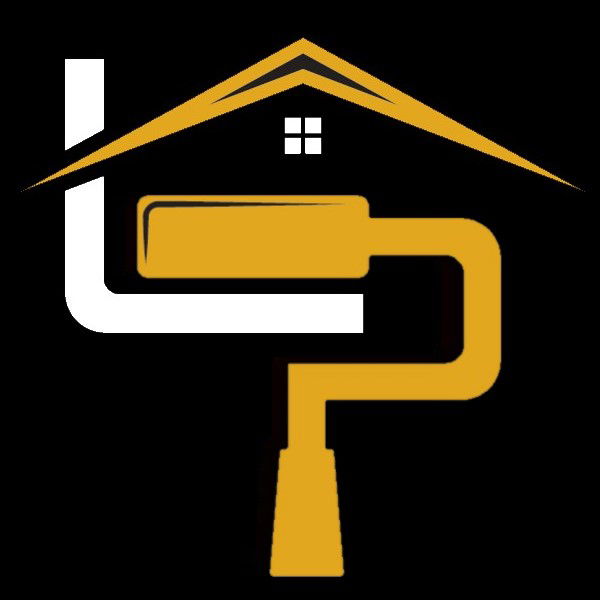Decoding the Dollars: Cost to Paint House Exterior - Are You Paying Too Much?
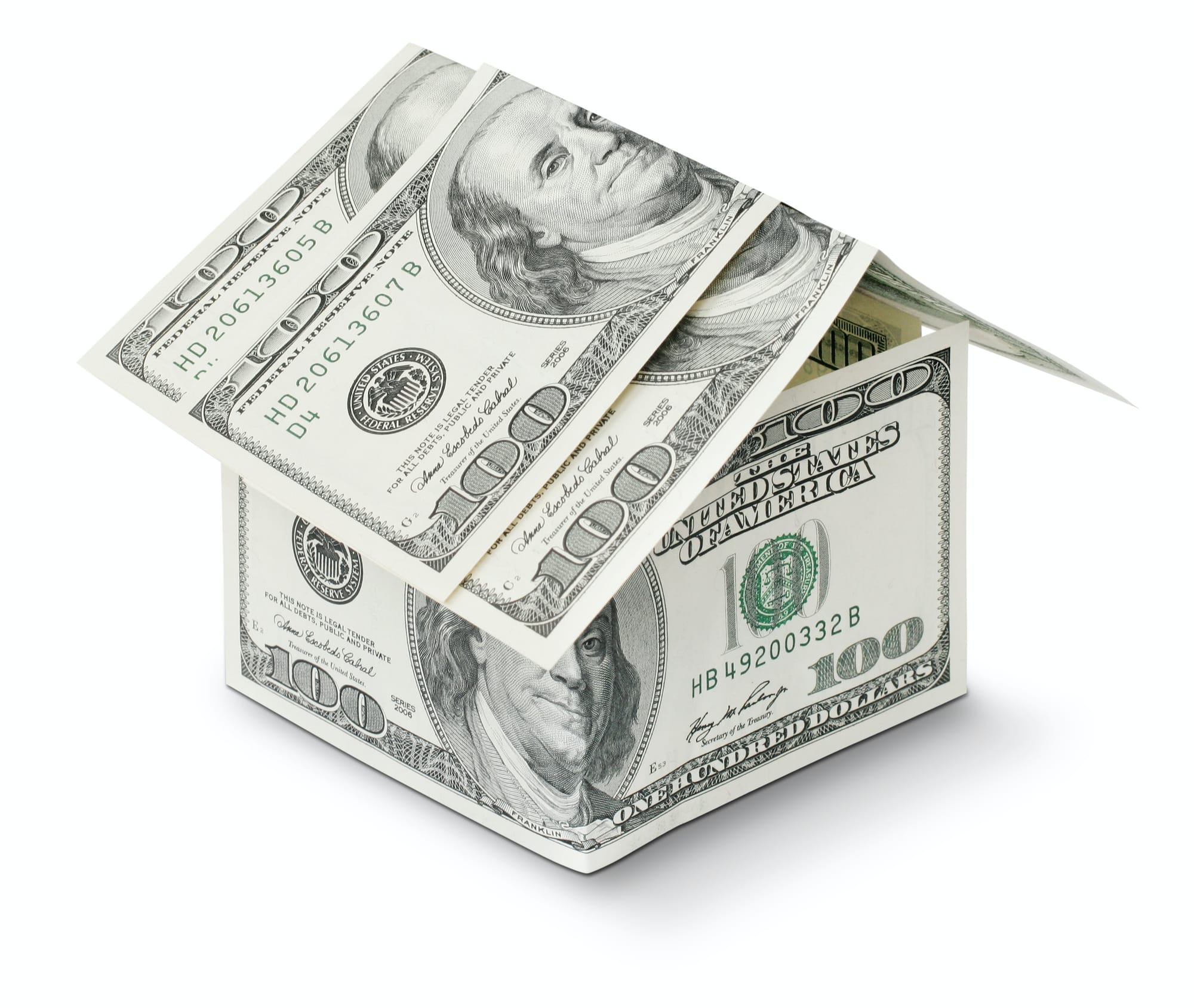
Key Features:
- Factors Influencing Cost:
- Size of the House: Larger homes require more paint and labor, increasing overall costs.
- Type of Siding: Different materials (wood, vinyl, brick, stucco) have varying preparation and paint needs, affecting costs.
- Condition of the Surface: Homes needing extensive prep work (cleaning, sanding, repairs) will incur higher costs.
- Quality of Paint and Materials: Higher-quality paints cost more but offer better coverage and durability, reducing the need for frequent repainting.
- Labor Costs: Varies by location and the painter’s experience, with urban areas generally having higher rates.
- Cost Estimation and Comparison:
- DIY vs. Professional Painting: DIY can save on labor costs but requires significant time and effort. Professionals are better for complex projects, high-quality finishes, and time constraints.
- Calculating Costs: Measure the home’s exterior, determine paint quantities needed, and use online estimation tools or get multiple quotes from professionals to ensure accurate cost estimation.
- Cost Variations by Region: Labor and material costs vary by region, with urban areas and regions with harsh climates generally incurring higher costs.
- Cost-Saving Tips:
- DIY Preparation: Handling prep work yourself can reduce labor costs.
- Buying in Bulk: Purchasing materials in bulk can lead to discounts and ensure sufficient supply.
- Timing Your Project: Painting during off-peak seasons or mild weather can reduce costs.
- Choosing Cost-Effective Options: Select the right paint and use primers wisely to balance cost and quality. Hiring local contractors can also save on travel costs and leverage local reputation and support.
What's the Cost to Paint the Exterior of Your House
Imagine driving up to a beautifully painted house that immediately catches your eye. The exterior paint not only enhances the home’s curb appeal but also protects it from the elements, significantly boosting its property value. Exterior painting is more than just an aesthetic upgrade; it’s a crucial maintenance task that ensures the longevity and health of your home.
I recall a homeowner in Portland who recently contacted us at Lightmen Painting, expressing shock at the cost estimate for painting their home’s exterior. They hadn't realized the various factors that influence the overall price. After a detailed explanation, they understood the investment was well worth it for the long-term benefits it would bring.
In this article, we aim to demystify the costs associated with exterior house painting. We will break down the various elements that contribute to the overall price, helping you understand what you’re paying for and ensuring you get the best value for your investment. Whether you're planning a DIY project or hiring professionals, this guide will equip you with the knowledge to make informed decisions and avoid overpaying.

Understanding the Basics of Exterior House Painting Costs
What Factors Influence the Cost?
Size of the House
The square footage of your home is one of the most significant factors in determining the cost of an exterior paint job. Larger homes require more paint and more labor, which naturally increases the overall price. For instance, painting a 2,000-square-foot house will cost more than painting a 1,500-square-foot house, as it involves more extensive preparation and painting time.
Type of Siding
The material of your house's siding also affects the cost. Different materials require different types of paint and preparation:
- Wood: Generally costs more to paint due to the need for sanding and priming.
- Vinyl: Less expensive as it requires less prep work, but special vinyl-safe paint is often needed.
- Brick: Typically more costly due to the textured surface that requires more paint and effort to cover.
- Stucco: Similar to brick, stucco surfaces can be more challenging and time-consuming to paint, increasing the cost.
Condition of the Surface
The state of your exterior surface can significantly influence the price. Homes with peeling paint, cracks, or other damage will require more prep work, such as cleaning, sanding, and repairing. This additional labor increases the total cost.
Quality of Paint and Materials
Not all paints are created equal. Higher-quality paints may cost more initially, but they offer better coverage, durability, and longevity. The choice of primers, brushes, rollers, and other materials also impacts the overall expense. Investing in quality materials can save you money in the long run by reducing the frequency of repainting.
Labor Costs
Labor costs can vary widely depending on your location and the experience level of the painters. Urban areas with a higher cost of living generally have higher labor rates. Additionally, experienced and reputable painters may charge more, but their expertise can result in a superior finish and fewer issues down the line.
Typical Cost Breakdown
Material Costs
- Paint: The most significant material cost, varying based on brand, quality, and type (e.g., latex vs. oil-based).
- Primers: Essential for ensuring paint adhesion and longevity, especially on bare or repaired surfaces.
- Brushes and Rollers: Quality tools can make a big difference in the finish and ease of application.
- Other Supplies: Includes tape, drop cloths, and cleaning supplies.
Labor Costs
- Professional Painters: Typically charge by the hour or by the square footage of the house. Average hourly rates can range from $25 to $50 per hour, with total costs depending on the size and complexity of the project.
- Prep Work: Additional labor for cleaning, sanding, and repairs, often billed separately or included in the overall hourly rate.
Additional Costs
- Scaffolding: Necessary for multi-story homes or hard-to-reach areas, which can add to the overall expense.
- Permits: Some areas may require permits for exterior painting, adding to the cost.
- Cleanup: Ensuring that the site is clean and free of debris after painting, which might be included in the labor cost or billed separately.
In Our Experience:
"Understanding the costs of exterior house painting can be quite an eye-opener for many homeowners. I recall a project in Portland where the homeowner was initially shocked by the estimate. After walking them through the factors influencing the cost—such as the size of the house, type of siding, and necessary preparation—they realized the value behind the investment. We explained how high-quality paint and professional application not only enhance the curb appeal but also protect the home from harsh weather, ultimately saving on future repairs. This transparency and attention to detail helped them see the long-term benefits, making the investment feel well worth it."
How to Estimate Your Painting Costs
DIY vs. Professional Painting - Pros and Cons of DIY Painting
Cost Savings vs. Time Investment and Quality
DIY painting can save you money on labor costs, which can be a significant portion of the total expense. You can also control the quality of materials and take your time to ensure every detail is perfect. However, DIY painting requires a substantial time investment and can be physically demanding. Additionally, achieving a professional-quality finish can be challenging without the right skills and experience.
Personal Anecdote
I remember tackling a DIY exterior painting project on my own home. The initial excitement quickly turned into frustration as I underestimated the amount of prep work required. It took several weekends to complete, and while the end result was satisfactory, I realized that a professional could have achieved a better finish in a fraction of the time.
When to Hire a Professional
Complex Projects
If your home has intricate architectural details, multi-story heights, or extensive damage that needs repair, hiring a professional painter is often the best choice. Professionals have the tools and experience to handle these complexities efficiently and safely.
High-Quality Finishes
For projects where a flawless finish is essential, such as high-end homes or homes being prepared for sale, professional painters can provide the expertise needed to achieve a superior result. They have access to high-quality materials and advanced techniques that can make a noticeable difference.
Time Constraints
If you have a tight deadline, such as preparing your home for a special event or putting it on the market, professionals can complete the job quickly and efficiently. This can save you time and reduce the stress associated with large DIY projects.
Calculating the Costs
Step-by-Step Guide
- Measure Your Home's Exterior
- Measure the perimeter of your home to determine the total linear footage.
- Measure the height of each section of your home, from the base to the roofline.
- Multiply the perimeter by the height to calculate the total square footage of exterior walls.
- Calculate Paint Quantities
- Determine the number of coats needed (usually two).
- Use the paint coverage rate (typically provided on the paint can, e.g., 350 square feet per gallon) to estimate the amount of paint required.
- Example: If your home has 2,000 square feet of exterior walls and you need two coats, you’ll need about 12 gallons of paint (2,000 sq ft / 350 sq ft per gallon x 2 coats).
Online Estimation Tools
Several reliable cost calculators can help you estimate the total cost of your painting project. These tools take into account the size of your home, the type of paint, and labor costs in your area. Some recommended tools include:
- Paint Calculator from Benjamin Moore
- Sherwin-Williams Paint Estimator
- Homewyse Paint Calculator
Getting Quotes from Professionals
- Research and Referrals
- Ask friends, family, and neighbors for recommendations.
- Read online reviews and check ratings on platforms like Angie’s List or Yelp.
- Request Multiple Quotes
- Contact at least three professional painting contractors to get a range of quotes.
- Provide detailed information about your project to ensure accurate estimates.
- Evaluate Quotes
- Compare the scope of work, materials included, and warranty offered by each contractor.
- Don’t just choose the lowest bid; consider the overall value and the contractor’s reputation.
- Ask Questions
- Inquire about the contractor’s experience, the quality of materials used, and the estimated timeline for completion.
- Ensure the contractor is licensed and insured.
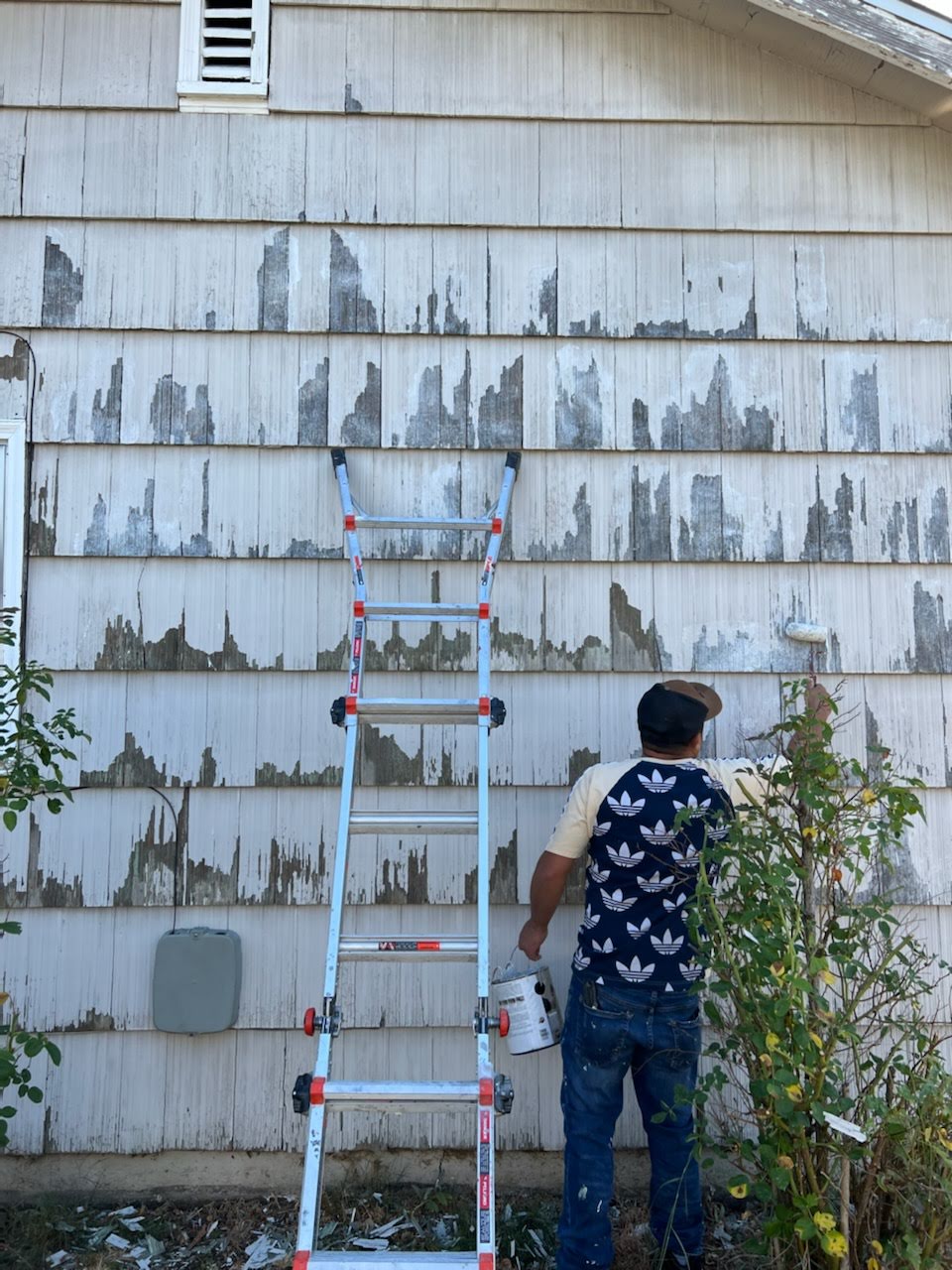
Tips to Save Money on Exterior House Painting
Preparing the Surface Yourself
DIY Preparation
One of the best ways to save money on your exterior house painting project is to handle the preparation work yourself. This includes:
- Cleaning: Use a pressure washer or garden hose to remove dirt, mildew, and loose paint. This ensures the new paint adheres properly.
- Scraping: Scrape off any peeling or flaking paint. This step is crucial for a smooth, even finish.
- Sanding: Sand the surfaces to smooth out any rough areas and to create a good surface for the new paint to stick to.
By doing these tasks yourself, you can significantly reduce the labor costs associated with professional painting services.
Buying Materials in Bulk
Purchasing paint and supplies in bulk can lead to substantial savings. When you buy larger quantities, many suppliers offer discounts. Additionally, buying in bulk ensures you have enough materials to complete the job without multiple trips to the store, saving time and potential additional costs.
Timing Your Project
Timing your project can also affect costs. The best times of year to paint are typically late spring and early fall when the weather is mild and dry. Additionally, many painting contractors offer discounts during their off-peak seasons, usually late fall and winter, as they look to keep their schedules full. Planning your project during these times can lead to savings.
Choosing Cost-Effective Options
Selecting the Right Paint
Choosing the right paint is crucial for balancing cost with quality. High-quality paints may have a higher upfront cost but can save money in the long run due to their durability and longer lifespan. They often require fewer coats, saving you money on the amount of paint needed and reducing labor costs.
Using Primer Wisely:Primer can be a money-saver if used correctly. In many cases, using a good primer will help the paint adhere better to the surface, reducing the number of coats needed. This is particularly important when painting over darker colors or on surfaces that have been patched. Some modern paints combine primer and paint in one, which can also be a cost-effective choice.
Hiring Local Contractors:Hiring local contractors can offer several benefits:
- Lower Travel Costs: Local painters may charge less for travel time and transportation costs.
- Community Reputation: Local contractors often rely on word-of-mouth and community reputation, so they are likely to provide quality service.
- Quick Response: Local contractors can quickly address any issues that arise during or after the project.
Additionally, local painters may have connections with local suppliers, possibly providing better prices on materials.
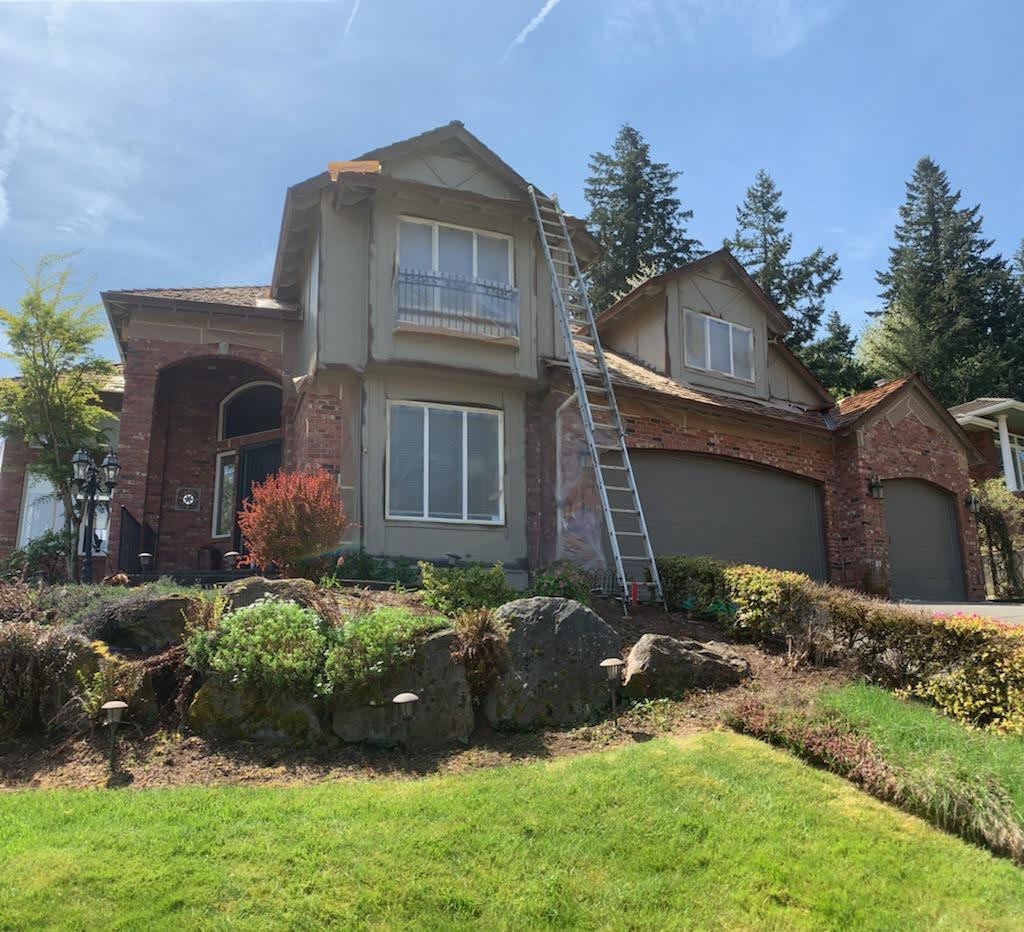
Comparing Costs in Different Regions
Cost Variations Across the US Regional Differences:
Painting costs can vary significantly across different regions of the United States due to several factors, including:
- Labor Rates: The cost of labor can be higher in certain areas due to the local cost of living and demand for services. For example, labor costs are generally higher in major metropolitan areas like New York City or San Francisco compared to smaller towns or rural areas.
- Material Prices: The price of paint and supplies can also vary depending on the region. Areas with higher transportation costs or fewer suppliers might experience higher prices.
- Climate Conditions: In regions with harsh weather conditions, the need for more durable and weather-resistant paints can increase costs. For instance, homes in coastal areas may require special coatings to resist saltwater corrosion.
- Regulations: Local regulations and building codes can affect the cost. Some areas might have stricter environmental regulations requiring the use of low-VOC paints, which can be more expensive.
Case Studies:
- New York City, NY: Due to high labor costs and the need for durable paint to withstand extreme weather, the average cost to paint a house exterior is significantly higher compared to other regions.
- Austin, TX: In Austin, labor costs are moderate, and the climate is relatively mild, leading to more competitive pricing for exterior painting projects.
- Seattle, WA: With its wet climate, Seattle homes often require more preparation work and specialized paints, which can increase the overall cost.
Specifics for Portland, Oregon
Local Cost Insights:
In Portland, Oregon, the average cost for exterior house painting can vary based on the size of the home, the type of siding, and the condition of the surfaces. On average, homeowners can expect to pay:
- Small Homes (1,000 - 1,500 sq ft): $2,500 - $4,000
- Medium Homes (1,500 - 2,500 sq ft): $3,500 - $6,000
- Large Homes (2,500+ sq ft): $5,000 - $8,000
These costs include labor, materials, and necessary preparation work. Factors such as the type of paint used, the complexity of the job, and any additional repairs needed can also affect the final price.Lightmen Painting Advantage:Lightmen Painting offers competitive pricing and high-quality service in the Portland area. Here’s what sets us apart:
- Competitive Pricing: We provide detailed and transparent estimates to ensure you understand where every dollar goes. Our pricing is competitive with local market rates while maintaining high standards of quality.
- High-Quality Service: Our team is experienced and skilled, ensuring top-notch results for every project. We use premium paints and materials to guarantee long-lasting and beautiful finishes.
- Local Expertise: Being based in Portland, we understand the unique challenges posed by the local climate. We tailor our approach to ensure your exterior paint job withstands the wet, rainy conditions typical of the Pacific Northwest.
- Customer Satisfaction: We prioritize customer satisfaction, offering personalized service and attention to detail. Our numerous positive reviews and repeat customers are a testament to our commitment to excellence.
By choosing Lightmen Painting, you can trust that your exterior painting project will be handled with the utmost care and professionalism, ensuring a beautiful and durable finish that enhances your home's curb appeal and value.
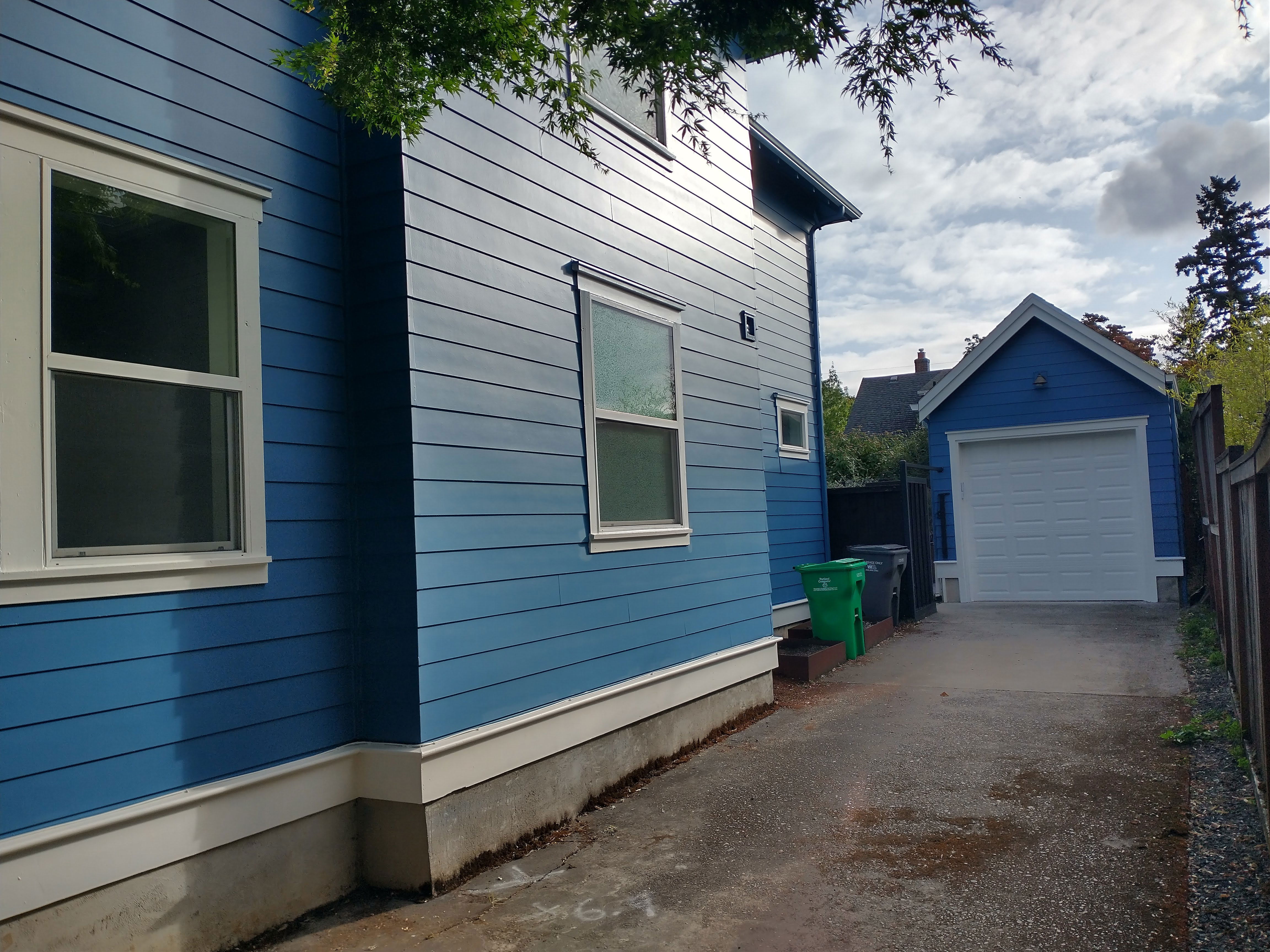
Ensuring You Get Value for Your Money
Evaluating the Quality of Work
Checklist for Quality Painting:
- Smooth Finish: Check for a uniform finish without brush strokes, roller marks, or streaks. The surface should be smooth and even.
- Coverage: Ensure the paint covers the surface completely without any bare spots or uneven color patches.
- Edges and Corners: Look at the edges and corners for clean, straight lines. There should be no paint on surfaces that should not be painted (e.g., windows, trim).
- Drips and Splatter: Inspect for any drips, splatters, or paint runs. High-quality work will have none of these imperfections.
- Surface Preparation: Verify that proper surface preparation was done, such as cleaning, sanding, and priming, to ensure the paint adheres well and lasts longer.
- Consistency: The paint color and finish should be consistent across the entire surface, with no noticeable differences between sections.
Common Mistakes to Avoid:
- Poor Surface Preparation: Skipping steps like cleaning, sanding, or priming can lead to peeling or uneven paint.
- Inconsistent Application: Uneven paint application can result in visible brush strokes or roller marks.
- Ignoring Weather Conditions: Painting in unsuitable weather conditions (too hot, too cold, or too humid) can affect the paint's drying and curing process.
- Using Low-Quality Paints: Cheaper paints can result in poor coverage, durability issues, and a less attractive finish.
- Rushed Work: Hurrying the job can lead to missed spots, drips, and an overall lower-quality finish.
Warranties and Guarantees
Importance of a Warranty:
- Protection: A warranty provides protection against defects in materials or workmanship, ensuring that if issues arise, they will be addressed at no additional cost.
- Confidence: A warranty reflects the painter's confidence in their work quality and commitment to customer satisfaction.
- Longevity: Warranties can extend the lifespan of your paint job by covering necessary touch-ups or repairs.
Questions to Ask:
- Coverage: What does the warranty cover (e.g., peeling, blistering, fading)? Make sure you understand the scope of coverage.
- Duration: How long does the warranty last? Look for warranties that offer coverage for several years.
- Exclusions: Are there any exclusions or conditions that might void the warranty (e.g., improper maintenance, extreme weather conditions)?
- Process: What is the process for filing a claim? Ensure you know the steps to take if you need to use the warranty.
Recap Key Points:
Understanding the factors influencing painting costs, evaluating the quality of work, and ensuring you get value for your money through proper warranties are essential steps in any exterior painting project.
Encouragement to Contact Lightmen Painting:
For high-quality exterior painting services that provide excellent value for your investment, consider contacting Lightmen Painting. We offer detailed quotes, professional expertise, and a commitment to customer satisfaction.
Action:
We invite you to share your experiences or ask questions in the comments section. Let us help you achieve the perfect paint job for your home!
Do You Have Questions? Give Us A Call With Any & All, Or To Schedule Your Free, No Obligation Estimate 503-389-5758
-
People Also Ask:
What factors influence the cost to paint the exterior of a house?
Several factors influence the cost, including the size of the house, the type of siding, the condition of the surface, the quality of paint and materials, and labor costs. Larger homes and those with more extensive prep work required will generally cost more.
Is it cheaper to paint the exterior of a house yourself or hire a professional?
DIY painting can save money on labor costs, but it requires a significant time investment and can be physically demanding. Hiring a professional ensures a higher-quality finish, faster completion, and potentially fewer issues down the line, but it comes at a higher cost.
What are some ways to save money on exterior house painting?
To save money, consider preparing the surface yourself, buying materials in bulk, timing your project during off-peak seasons, choosing cost-effective paint options, and hiring local contractors. These steps can help reduce the overall cost while still achieving a quality finish.
-
SUBSCRIBE TO OUR BLOG: Stay informed with the latest in Painting and DIY projects by subscribing to Lightmen Painting. Get insights, tips, and more delivered straight to your inbox. We would also love to know what you would like to read about, leave thoughts on where we should go next. Interests, Topics, Ideas, all are welcome.
If your in the Portland, Or. area and need advice or a free no obligation estimate call us at 503-389-5758 or email scheduling@lightmenpainting.com
Local Shout Out:
Celebrating the United States Marine Corps: Honoring Bravery and Commitment
From the team at Lightmen Painting, we extend our deepest respect and gratitude to the United States Marine Corps. Known for their unmatched bravery, dedication, and service to the nation, the Marines embody values that resonate deeply with our own commitment to excellence and integrity in our work. Just as the Marines are always ready to protect and serve, we strive to provide reliable and high-quality painting services that stand the test of time. We honor the Marines for their unwavering commitment to safeguarding our freedoms and ensuring national security.
Thanks for stopping by Lightmen Daily! Stay tuned for more practical tips and expert advice on making your painting projects flawless, from wall to floor!
Definitions
- Curb Appeal: The attractiveness of a property as viewed from the street, often enhanced by exterior painting.
- Exterior Painting: The process of applying paint to the outer surfaces of a house to protect it from the elements and improve its appearance.
- Square Footage: The total area of the surfaces to be painted, measured in square feet, influencing the amount of paint and labor required.
- Siding: The outer covering of a house's exterior walls, which can be made from various materials like wood, vinyl, brick, or stucco.
- Peeling Paint: Paint that has lost its adhesion and is coming off the surface, requiring preparation before new paint is applied.
- Primers: Undercoat paints applied to prepare surfaces for the final coat, enhancing adhesion and durability.
- Labor Costs: The expenses associated with hiring professionals to perform the painting work.
- Scaffolding: Temporary structures used to support workers and materials during construction or painting, particularly for multi-story buildings.
- Permits: Official permissions required in some areas to carry out construction or painting work.
- DIY (Do It Yourself): A project completed by a homeowner without professional help, often to save money.
- Professional Painters: Trained and experienced individuals or companies hired to perform painting tasks to a high standard.
- Paint Coverage Rate: The area a specific amount of paint can cover, usually measured in square feet per gallon.
- Low VOC (Volatile Organic Compounds): Paints with reduced levels of harmful chemicals, making them more environmentally friendly and safer for indoor use.
- Online Estimation Tools: Digital calculators that help estimate the cost of painting projects based on various inputs like size and type of paint.
- Touch-Ups: Small repairs or additional painting needed to correct imperfections or maintain the paint job over time.
Lightmen Painting Serving: Portland, Tigard, Lake Oswego, Tualatin, West Linn, Milwaukie, Sherwood, Happy Valley, Oregon City, Beaverton, Hillsboro, Gresham
